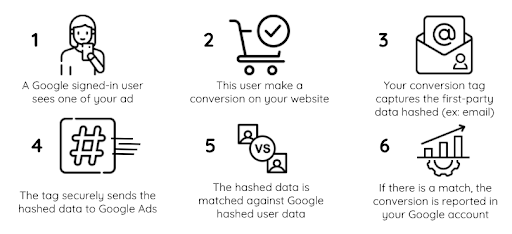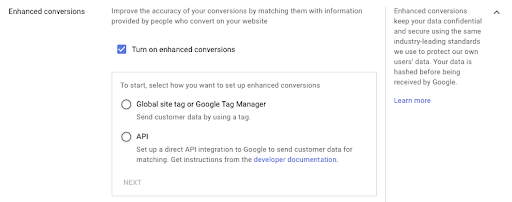Privacy measures like GDPR, the launch of iOS14, and the disappearance of cookies by 2023 are making marketers' lives increasingly difficult. Indeed, it will become more and more challenging to track and target consumers across different devices and channels. These changes mean that topics such as measurement and attribution that are already complicated now will become even more so in the future.
Concretely, for marketers, this will have an impact on digital strategies as we will start to see a decline in ad performance over time as conversions will be underreported.
In this area of change, all publishers are investing in finding alternatives and developing their own methods to respond to it. In this article, you will find more explanations on the solution proposed by Google called Enhanced Conversion. This solution allows the use of first-party consumer data to track performance and try to limit the decline of your campaigns.
What are Enhanced Conversions?
As explained above, enhanced Conversions is a new Google Ads feature. It will allow you to improve the accuracy of your conversion measurement when cookies are not available using first-party data. This is made possible by using first-party data that has been securely hashed. Effectively, hashing the data before sending it to Google Ads ensures user privacy.
This way, advertisers can send hashed (de-identified) customer data from their conversion page (e.g. email addresses), which will then be matched to Google's logged-in data. Enhanced conversions are not intended to replace standard conversion tracking, but instead, complement it with more data.

As a result, enhanced conversions can help advertisers more effectively measure campaign results across multiple devices, even when users are not logged into the same email address on each device.
What are the benefits?
- Provide more robust conversion tracking
- Increase the accuracy of conversion attribution
- Improve modeling accuracy and reporting
- Provide more data-driven optimization
Requirements before you start
If you are convinced and now want to start implementing enhanced conversions, here are the elements you should take into account before starting:
- You need to know your site's code and when and how a conversion is triggered
- You need to make sure that first-party data is available and stored on the page where the conversion happens
- You must read and accept Google’s enhanced conversions data policy that you can find here.
Once these three elements are completed, you need to go to your Google Ads account in Tools > Measurement > Conversions and click on the conversion where you want to set up enhanced conversions. At the bottom of the ‘enhanced conversions’ section, click ‘Turn on enhanced conversions.’ You will then need to read the compliance statement, agree to it, and then click on ‘Check URL’ to check your website for a Google tag.

What about the implementation?
Enhanced conversion tracking will require some minor changes to your tagging configuration, depending on whether you use Google Tag Manager (GTM) or Google Ads Global Site tag (gtag). You can find more information about these setups in the Google guides here for GTM and here for Global Site tag.
In my next article, you will find a concrete case on how to do the implementation via GTM. In the meantime, I can already tell you that it can take up to 5 days to see the new options appear in GTM after the activation in Google Ads.
Conclusion
In conclusion, Enhanced Conversion is a new feature developed by Google to help businesses measure and improve their advertising effectiveness. Moreover, it allows us to realize that first-party data is more valuable than ever in this area of change.
As you can probably guess, I recommend to all marketers to plan the implementation of enhanced conversions in your Google Ads account and I will explain a concrete case in my next article.
